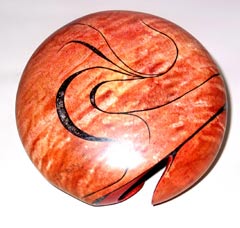
In Stephen Hatcher’s more than capable hands, nature unveils its beauty in an unlikely marriage of stone, dye, carving, and turning. Combining inlaid ground stone, gold, and pigments in an acrylic matrix paired with dyed, highly figured wood, Hatcher creates some of the most dazzling works of art ever to emerge from the jaws of a lathe chuck.
Looking at his work, it is hard to believe that this fifty-one-year-old inventor is but a relative newcomer to the field of turning. He started in 1998, when his father-in-law bought a Sears lathe. He bought one, too, and promptly broke it a few months later by overloading it. Fortunately, he has graduated to a sturdy Oneway lathe, and there is little likelihood he’ll overload that.
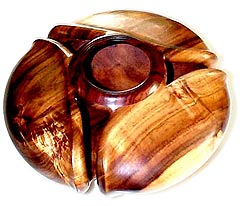
These days, woodturning is his day job, but it has only been so for the past year and a half. After earning degrees in both electrical engineering and math, he went to work for the Boeing Company. He left after five years to found Summit Design, a contract product development company that designs electronic products. Among his inventions is a differential GPS that allows a global positioning system to be accurate to about two feet.
To be fair, he has had some wood in his history. He worked his way through college remodeling and doing simple woodworking, and did some refinishing at home, but was not what you would call a woodworking hobbyist. A trip out of state changed all that.
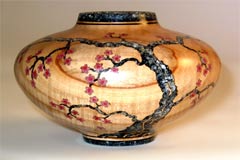
“I went to the Utah woodturning symposium in ’98,” he told me, “and took a class with Kip Christensen on stone inlay and carving. It was a powerful influence on me and I was hooked.” It didn’t take long before Hatcher went from student to teacher. He’s done articles for several magazines about his technique, and taught at woodworking and turning clubs. In an ironic twist of fate, he has been invited back to the same Utah symposium this year to demonstrate his singular technique of stone inlay and carving.
That’s not surprising. His work is so innovative and beautiful that it has already started to make its way into juried shows and galleries, where it garners both awards and collectors. His latest twist is creating translucent rims and inserts by carving, filling the voids with stone, then turning away the wood behind it.
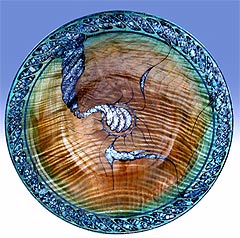
Working with stone in wood presented a number of technical problems he had to overcome. “Stone tends to break under stress,” Stephen explained. “You can’t turn it as you’d turn wood or even soft stone like alabaster.”
“First I turn the wood and look at the figure, which dictates the inlay. Sometimes I’ll photograph the figure and try drawing different inlay designs on it to decide what I want. Then, I carve out the areas for inlay with a Dremel tool and inlay the voids with layers of stone and cyanoacrylate glue. I grind it down with an angle grinder fitted with a five inch sanding pad, the sort used to finish marble or granite counter tops.”

To deal with the combination of wood and stone dust, he uses a whole house fan that moves 7500 cubic feet of air per minute, in addition to wearing ear protection, a face mask, and a respirator connected to a pump that feeds clean air to his face.
“After the inlay is leveled, I airbrush dye to pop out the wood’s figure and pull the image together, then sand it again to about 1000 grit to remove the fur. That makes the dye even more pronounced. Sometimes I’ll add a second dye coat to give it more depth. On top of that, I flood on a mixture of linseed oil, Danish oil, and mineral spirits, let it soak in for fifteen minutes, wipe it off, and let it dry for a week. Finally, I buff it and apply paste wax, let it dry, and buff it to a shine. I always put a little inlay on the back, on the foot, where my signature is, to tie in with what is on the front.”
For inlay, he uses mostly calcite, which comes in a variety of colors and is about as hard as a copper penny, azurite, which is deep blue, and earth pigments. “I’ve also used pink and white dolomite and gold leaf,” he added. “I grind the stone in a coffee grinder, size it through sieves, and use different sizes for different looks.”
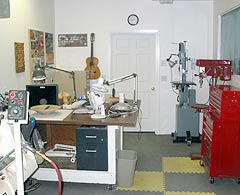
His designs run the gamut from carved and turned forms to lush images drawn from nature. “Friends call me a naturalist,” he says. “I watch what is going on in nature, and look at the structure of things, and it shows up in my work. Each is unique, and each is an extension of my own soul.”
While he openly teaches his methods to anyone who wants to learn, he is quick to point out that it is best to find one’s own path. “Turners often try to find a unique niche by looking at other peoples’ work. I looked for what I like to do, and ended up finding something I love.”
“Don’t force it,” he advises. “Be patient, experiment with a lot of different ideas, and follow your own love.”





